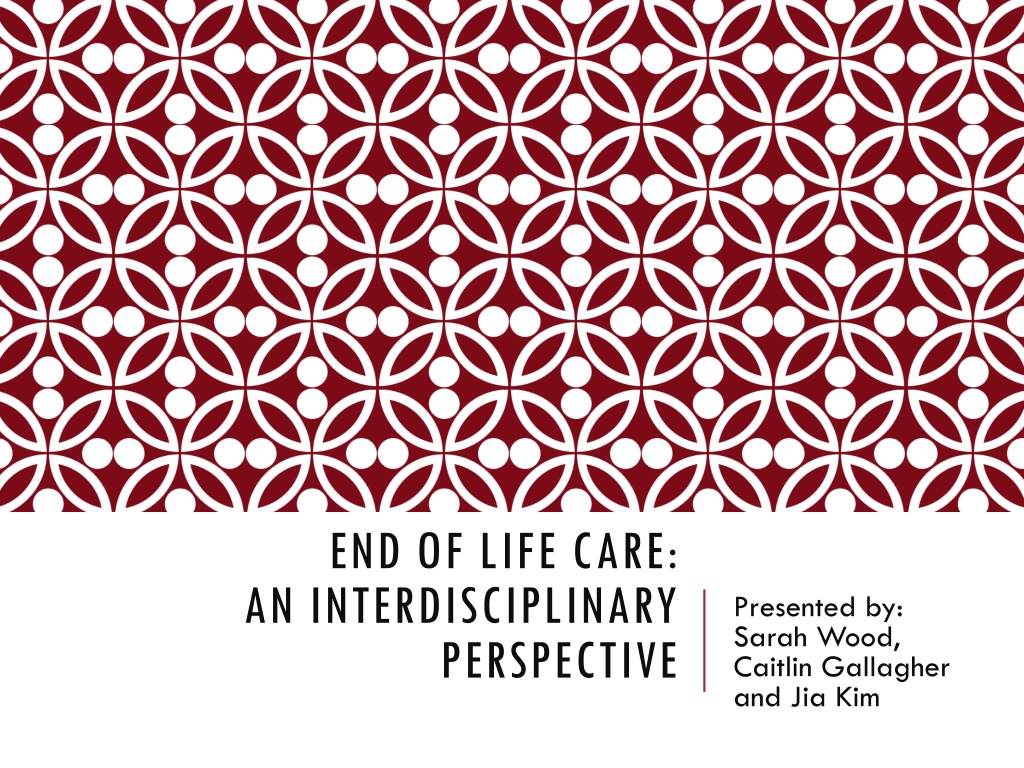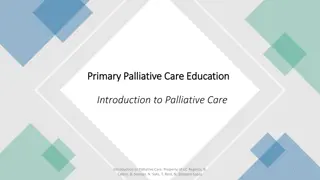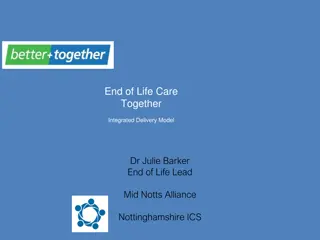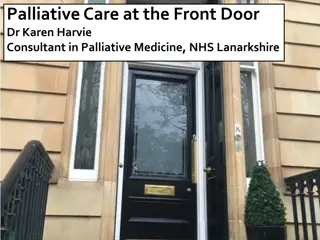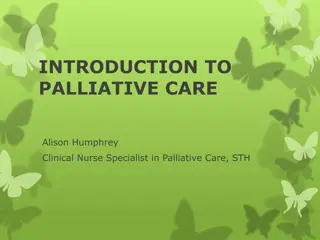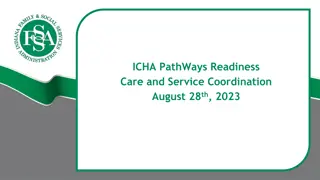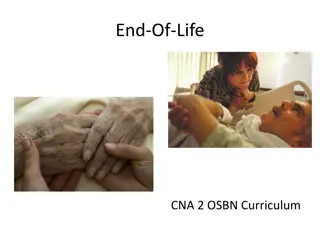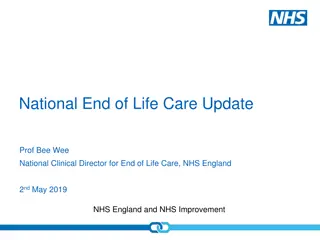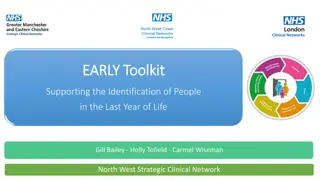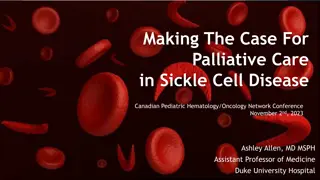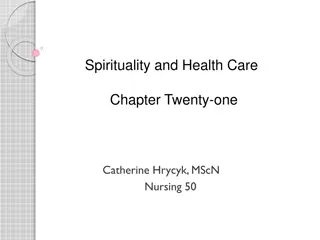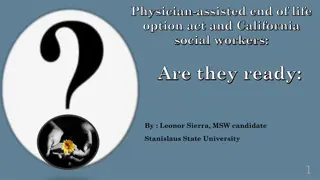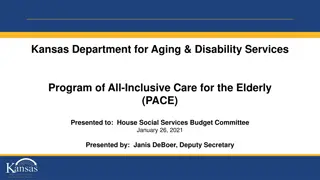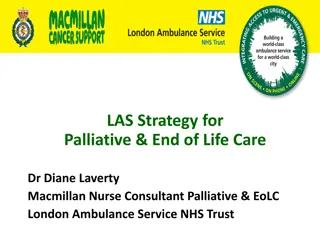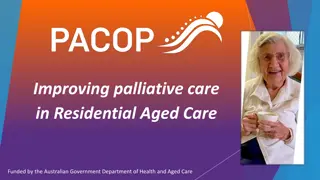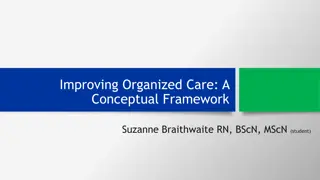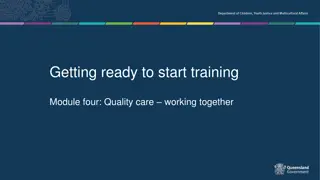Interdisciplinary Perspectives on End-of-Life Care
Exploring end-of-life care through an interdisciplinary lens, this presentation delves into social work, physical therapy, pharmaceutical aspects, and recommended interventions. Delicate considerations, diverse viewpoints, and evolving challenges in end-of-life decisions are examined, along with the crucial role of social work in providing practical support, emotional counseling, and facilitating advanced directives. Advanced directives, including Do Not Resuscitate orders and health care power of attorney, address critical healthcare decisions, while DSM considerations touch on depression at the end of life.
Uploaded on Sep 23, 2024 | 0 Views
Download Presentation

Please find below an Image/Link to download the presentation.
The content on the website is provided AS IS for your information and personal use only. It may not be sold, licensed, or shared on other websites without obtaining consent from the author. Download presentation by click this link. If you encounter any issues during the download, it is possible that the publisher has removed the file from their server.
E N D
Presentation Transcript
END OF LIFE CARE: AN INTERDISCIPLINARY PERSPECTIVE Presented by: Sarah Wood, Caitlin Gallagher and Jia Kim
AGENDA End of life care from a social work perspective End of life care from a physical therapy perspective End of life care from a pharmaceutical perspective Recommended Intervention
SOCIAL WORK CONSIDERATIONS AT THE END OF LIFE
VIEWS AT THE END OF LIFE Ample make this bed, Make this bed with awe! In it wait til judgment break Excellent and fair - Emily Dickinson Do not go gentle into that good night Rage! Rage! Against the dying of the light - Dylan Thomas
ISSUES THAT COMPLICATE END OF LIFE DECISIONS & CARE In the past, people died mostly of infectious diseases and life expectancy was short Life expectancy was 46 years old in 1900 People are living longer with chronic illnesses instead of dying younger from acute illnesses Life expectancy in 2010 was 77
SOCIAL WORK ROLE IN END OF LIFE CARE The social work role in end of life care has many facets Practical Advanced Directives Providing education, information and referral Funeral/burial planning and assistance Emotional Supportive counseling for patients and families Life Review Activities Clinical Assessment and treatment concerns Mental health support
ADVANCED DIRECTIVES Do Not Resuscitate (DNR) Medical Options for Scope of Treatment (MOST) Health Care Power of Attorney Financial Power of Attorney Living Will Five Wishes
WHAT DO ADVANCED DIRECTIVES ADDRESS? Cardiopulmonary Resuscitation Palliative Care IV fluids Antibiotics Tube feedings Hospice
DSM CONSIDERATIONS: END OF LIFE Depression DSM-IV Criteria for Major Depressive Disorder Depressed mood or a loss of interest or pleasure in daily activities for more than two weeks Impaired function: social, occupational, educational Specific symptoms, at least 5 of these 9, present nearly every day: Depressed mood or irritable most of the day, nearly every day, as indicated by either subjective report Decreased interest or pleasure in most activities, most of each day Significant weight change (5%) or change in appetite Change in sleep: Insomnia or hypersomnia Change in activity: Psychomotor agitation or retardation Fatigue or loss of energy Guilt/worthlessness: Feelings of worthlessness or excessive or inappropriate guilt Concentration: diminished ability to think or concentrate, or more indecisiveness Suicidality: Thoughts of death or suicide, or has suicide plan
DSM CONSIDERATIONS: END OF LIFE Anxiety DSM-IV Criteria for Generalized Anxiety Disorder Excessive anxiety and worry (apprehensive expectation), occurring more days than not for at least 6 months, about a number of events or activities (such as work or school performance) The person finds it difficult to control the worry The anxiety, worry, or physical symptoms cause clinically significant distress or impairment in social, occupational, or other important areas of functioning Specific symptoms, at least 3 of these 6, present nearly every day: Restlessness or feeling keyed up or on edge Being easily fatigued Difficulty concentrating or mind going blank Irritability Muscle tension Sleep disturbance (difficulty falling or staying asleep, or restless unsatisfying sleep)
DSM CONSIDERATIONS: END OF LIFE Delirium DSM-IV Criteria for Delirium Disorder Disturbance of consciousness (i.e., reduced clarity of awareness of the environment) with reduced ability to focus, sustain or shift attention A change in cognition or the development of a perceptual disturbance that is not better accounted for by a preexisting, established or evolving dementia The disturbance develops over a short period of time (usually hours to days) and tends to fluctuate during the course of the day There is evidence from the history, physical examination or laboratory findings that the disturbance is caused by the direct physiological consequences of a general medical condition
DSM CONSIDERATIONS: END OF LIFE Suicide, Assisted Suicide or Desire for Hastened Death Occasional thoughts of suicide are common in terminally ill patients Considerations of euthanasia and assisted suicide are not uncommon among this population; however, actual requests for such are far less common.
PALLIATIVE CARE Palliative care Greek: to cloak or surround your patient with caring. Palliative care is treatment of a patient s symptoms when cure might not be possible, in order to provide the greatest quality of life for as long as possible. Can be offered at any stage of illness and may help support a patient for many years The outcomes for palliative care are to relieve distressing symptoms, ease pain and enhance quality of life
LIFE REVIEW ACTIVITIES Reminiscence can be therapeutic for individuals at the end of their lives Reflection on memories can create a renewed sense of identity and self-worth Has been shown to be effective in improving the feelings of dignity and spiritual well being of terminally ill individuals
PHYSICAL THERAPY Improving a person s ability to move and perform functional activities INTERVENTIONS IN END OF LIFE
GOALS OF PHYSICAL THERAPY AS PART OF END OF LIFE CARE Maintain quality of life, independence, and dignity through the dying process Pain management Maximize functional capabilities Remain within the home Specific one last wish
APPROACHES TO PHYSICAL THERAPY IN THE PALLIATIVE CARE OR HOSPICE ENVIRONMENT Rehab Light- Decreased intensity/frequency/duration of physical therapy services are delivered Rehab in Reverse- Helping the patient and family transition through periods of physical decline Case Management- Periodic re-evaluations for HEP, education, awareness Skilled Maintenance- To improve the QoL in complex patients who may need services other than what can be taught to/performed by the caregiver Supportive Care- Assisting in management of pain, physical functioning, and QoL
INTERVENTIONS Pain Management Functional Mobility Falls Risk Assessments Lymphedema Management Patient and Family Education DME/Adaptive equipment Exercise
INTERVENTIONS Pain Management TENS units Ice/heat Massage Positioning
INTERVENTIONS Functional Mobility Mobility within the community vs home vs bed Level of assistance needed Energy expenditure Manage pt s effort WC vs cane Endurance (in the case of COPD or HF or heart disease) Six minute walk test Gait speed May be very goal oriented i.e. last wish may be to participate in a specific activity
INTERVENTIONS Falls Risk Assessments Prevent falls by screening individual s balance Berg; Tinetti; TUG Avoid complications due to falls Consider medication side effects Assess home environment Lighting Furniture/tripping hazards Wearing shoes Using assistive device rather than furniture crawling
INTERVENTIONS Sitting to standing Standing unsupported Sitting unsupported Standing to sitting Transfers Standing with eyes closed Standing with feet together Reaching forward with outstretched arm Retrieving object from floor Turning to look behind Turning 360 degrees Placing alternate foot on stool Standing with one foot in front Standing on one foot Berg Balance Scale Assessment tool that categorizes fall risk Can be used to help determine areas for improvement/intervention http://www.aahf.info/pdf/Berg_Balance_Scale.pdf
INTERVENTIONS Lymphedema Management Post surgical complication Most common with breast, uterine, ovarian cancers which involve the lymph nodes Lymphedema Massage Educate pt about self massage Compression garments Bandaging
INTERVENTIONS Patient and Family Education Educate patient regarding benefits of physical therapy interventions Educate family Regarding involvement in physical therapy interventions Regarding proper body mechanics during home care Regarding bed mobility/positioning/skin care Ulcers
BONY PROMINENCES Heels Malleoli Sacrum Ischial Tuberosities Scapula Spine http://www.selectmedical.co.uk/pressurecare.html
PRESSURE ULCERS Vascular Insufficiency Immobility Impaired Cognition Aging Pressure Ulcers
INTERVENTIONS Durable Medical Equipment (DME) and Adaptations Assistive devices Canes Walkers Wheelchairs Lifts Commodes, shower seats, grab bars
INTERVENTIONS Exercise / Physical Activity Promotes well being for some individuals Exercise as part of palliative care in terminal cancer patients has been shown to improve physical performance, reduce physical fatigue, and improve emotional functioning suggesting its use in this setting Maintain strength to remain as independent as possible for as long as possible
CASES In what ways might physical therapy services benefit this patient?
PHARMACY OVERVIEW AT THE END OF LIFE
GOALS OF PHARMACY TX AT END OF LIFE To make patient as comfortable as possible via pharmacologic agents To manage the chronic pain or any pain associated with disease states or conditions To individualize medication therapy to produce optimal efficacy with minimized adverse effects To improve quality of remaining life of the patients
MEDICATIONS TO EASE PAIN Palliative sedation, when appropriately indicated and correctly used to relieve unbearable suffering, does not have any detrimental effect on survival of patients with terminal cancer and it is a medical intervention that must be considered as part of a continuum of palliative care (Maltoni, Scarpi, Rosati, Derni, Fabbri, Martini, Amadori & Nanni, 2012)
CHARACTERIZING PAIN Palliative Factors What makes the pain better? P Provocative Factors What makes the pain worse? Quality Describe the pain. Q Radiation Where is the pain? R Severity/Intensity How does this pain compare with other pain you have experienced? S Temporal Factors Does the intensity of the pain change with time? T
MEDICATIONS TO EASE PAIN Strong Opioids oMorphine oHydromorphone oOxycodone oMethadone oFentanyl oOxymorphone NSAIDs oIbuprofen, naproxen, diclofenac , ketorolac oCelecoxib Anticonvulsants and Antidepressants Weak Opioids oCodeine oHydrocodone/APAP oTramadol Benzodiazepines
CONSIDERATIONS FOR MEDICATIONS Opioids adverse effects: oSedation/cognitive impairment/nausea/pruritis oRespiratory failure o Rare if appropriate starting doses are used o Pain control Somnolence Respiratory depression oUrinary retention o**Constipation** o Start bowel regiment with opioids (Stool softner + stimulant/osmotic) NSAIDs adverse effects: oGI bleeding, decreased GFR (reduced kidney function), decreased platelet aggregation
OPIOID MYTHS The amount of analgesia opioids can produce is limited The more potent opioids are the more therapeutically superior opioids Taking opioids for pain relief often leads to addiction and dependence
WHEN TO DISCONTINUE MEDICATIONS http://abcnews.go.com/WNT/video/life-death-10785807 The decisions for discontinuation must be individualized Considerations: the patients goals of therapy, life expectancy, risk/benefits of discontinuation, and comorbidities Medications for chronic illness may not be helpful late in life
STEPS TO DISCONTINUING MEDICATIONS 1. Recognizing an indication that may warrant discontinuing a medication 2. Prioritizing the medication to discontinue 3. Discontinuing the medication 4. Monitoring the patient for beneficial or harmful effects
BARRIERS TO DISCONTINUING MEDICATIONS Concern about what discontinuing medication implies ( giving up ) Uncertain of risks with discontinuation Physical dependence and psychological attachment Poor communication (cost effectiveness)
MEDICATIONS TO CONSIDER DISCONTINUING IN END OF LIFE Cholesterol lowering therapy (-statins) Anti-platelet agents (aspirin, Plavix) Anti-coagulants (Coumadin, Lovenox) Dementia medications (Aricept, Exelon, Namenda) Osteoporosis medications (Fosamax, Actonel, Boniva, Reclast) Chemotherapy
TAKE-AWAY MESSAGE Discontinuing medications must be individualized and based on patient s wishes It must be well communicated between providers and patients/families/care givers Check out all the considerations If done correctly, medications can be discontinued safely and effectively without causing an adverse drug withdrawal event
OVERALL RECOMMENDATION Hospice Care
HOSPICE CARE-WHAT IS IT? A Medicare program which offers benefits and services for seriously ill people who have a disease that may cause their death within six months Provides a team-oriented approach to medical care, pain management, emotional and spiritual support specific to the individual Hospice focuses on living the best quality of life possible for as long as possible At the core of Hospice care is the belief that we all have the right to die with dignity and be pain-free in the process
HOSPICE CARE- ELIGIBILITY Criteria for Hospice There is a terminal diagnosis The patient has chosen palliation as a goal rather than cure There is a caregiver available The patient chooses the financial hospice benefit Average life expectancy of six months or less
HOSPICE CARE- INTERDISCIPLINARY TEAM A Hospice team includes The patient s personal physician Hospice physician Nurses Home health aides/certified nursing assistants Social workers Spiritual providers Trained volunteers Speech, physical and occupational therapists
HOSPICE CARE- SERVICES PROVIDED Pain and symptom management Emotional, psychosocial and spiritual support around dying Home nursing visits Medications related to the terminal diagnosis Medical supplies and durable medical equipment Therapy services Support with activities of daily living Respite care for caregiver End-of-life education for the patient and family Counseling to family and friends Bereavement support for 13 months after the death of the patient
SETTINGS FOR HOSPICE/PALLIATIVE CARE Home Facility Skilled Nursing Assisted Living Hospice Facility Hospital
REFERENCES: SOCIAL WORK Chung, K. (2012). End of life care. Sage Knowledge Publications. Retrieved from: http://dx.doi.org.libproxy.lib.unc.edu/10.4135/9781412950510.n293 Kartman, L.L. (1990). Life review. Activities, Adaptations & Aging, 15(3). 45-52. doi: 10.1300/J016v15n03_03 National Hospice and Palliative Care Organization. (2103). Hospice Care. Retrieved from: http://www.nhpco.org/about/hospice-care National Hospice and Palliative Care Organization. (2013). Palliative Care. Retrieved from: http://nhpco.org/palliative-care-0 Pessin, H., Rosenfeld, B., & Breitbart, W. (2002). Assessing psychological distress near the end of life. American Behavioral Scientist, 46(3). 357-372. doi: 10.1177/000276402237769 Pickrel, J. (2007). Tell me your story: Using life review in counseling the terminally ill. Death Studies, 13(2). 127-135. doi: 10.1080/07481188908252290
